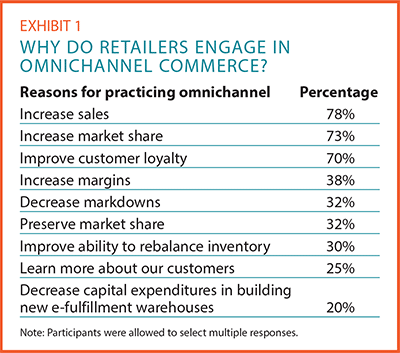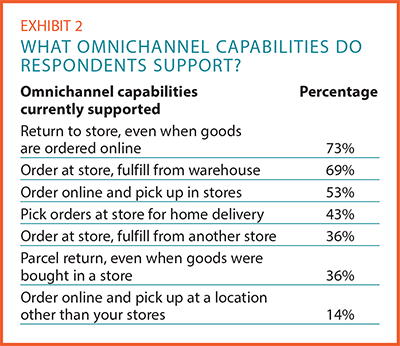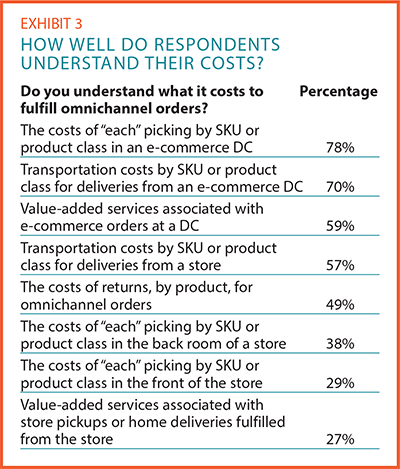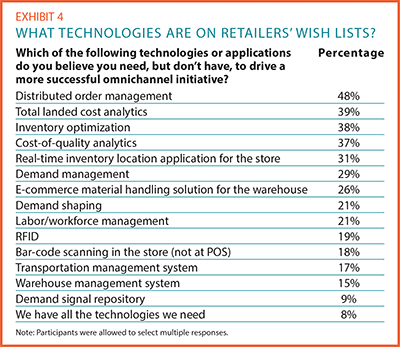Stores: the weak link in omnichannel distribution
It's a rare retailer these days that relies solely on business transacted in brick-and-mortar stores. Many, if not most, have hopped on the multichannel bandwagon, selling merchandise through both physical and digital (e-commerce) channels. And the evolutionary journey is by no means over. Many of the leading retailers are now well down the road to what's become known as "omnichannel commerce."
What's omnichannel commerce? Definitions vary, but for purposes of this article, we'll use the term to refer to retailers' efforts to integrate their store and e-commerce selling channels to work seamlessly together. The overarching idea is to enable customers to shop by any channel they choose and even use more than one channel to execute a single transaction. For example, a customer can go to a store, see something he or she likes, and order it for home delivery or order it online and pick it up at a store. More than likely, he or she will have similar options for returns.
People tend to bandy about the terms "multichannel" and "omnichannel" as if they were interchangeable. But for purposes of this research, we've drawn a distinction between the two. We use the term "multichannel" to refer to companies selling goods through multiple channels – i.e., stores, distributors, e-commerce, and so forth. The term "omnichannel," however, refers to a special form of multichannel commerce practiced by retailers who sell goods both through stores and over the Internet. The aim of these retailers is to integrate operations so as to provide a seamless shopping experience for customers.
The emergence of omnichannel commerce is not news, of course. The trend has been under way for some time and has been well documented in both business and consumer media. What often goes unaddressed, however, is the impact on the back end of the operation—the retailer's order fulfillment and delivery activities.
To get a better understanding of where things stand from a distribution perspective, ARC Advisory Group and DC Velocity teamed up to do a study. The research, which was conducted among 177 executives at retailers that sell goods through both traditional brick-and-mortar stores and websites, sought to answer a number of key questions: Just how far down the omnichannel road have retailers gotten? How have they altered their operations to meet the new demands? And perhaps most important, how well are they meeting the omnichannel distribution challenges?
STANDING UP TO AMAZON
Conventional wisdom holds that the omnichannel revolution was sparked by traditional merchants fighting back against incursions into their market by the likes of Amazon.com. Then last year, Amazon turned up the heat when it announced it would build out a distribution network that would allow for same-day deliveries in certain parts of the United States.
The pressure felt by retailers is reflected in the responses to our survey question on why their companies engaged in omnichannel commerce. Although study participants cited a number of reasons, the majority (78 percent) said it was to increase sales, and nearly three-quarters (73 percent) said it was to boost market share. (See Exhibit 1.) Other reasons cited included increased customer loyalty and higher margins, which helps explain why leading retailers are spending billions of dollars to improve their capabilities in this area. (By way of demographics, about a third – 33 percent – of the survey respondents came from the apparel sector, 15 percent from "big box" stores, another 15 percent from department stores, and the remainder from other types of retailers. Eighty-seven percent of study participants were based in the United States.)

When asked what options they offered customers, the respondents cited a wide array of capabilities. Topping the list was "walk-in" returns – 73 percent of respondents said their company provided for the return of goods ordered online to a store. Another 69 percent said they allowed customers to order products at the store for fulfillment from the warehouse or DC. Fifty-three percent offered consumers the option to order online and pick up the merchandise at the store. Forty-three percent picked orders at the store for home delivery. Another 36 percent allowed customers to order at a store but fulfilled that request from another store. Interestingly, 14 percent allowed customers to order goods online but let them pick up the items at a location other than their stores, such as a gas station or convenience store. (See Exhibit 2.)

To succeed in omnichannel distribution, retailers will have to pick the optimum distribution path, whether it's order in-store and deliver to home, or order online and fulfill from any store or warehouse location. Each option has a different cost structure that retailers need to thoroughly grasp, particularly when it comes to the incremental value of speedy home delivery service.
What emerged from the study, however, was evidence of a wide gap in the cost accounting capabilities of DCs versus stores. While most respondents could pinpoint the costs associated with various activities at the DC, few have an equally clear picture of the corresponding costs for store fulfillment. (See Exhibit 3.) For example, 78 percent of respondents said they knew the cost of picking individual items or "eaches" by stock-keeping unit (SKU) or product class in their e-commerce distribution center. But only 38 percent could pin down the corresponding costs for the back room of a store, and only 29 percent said they understood the expenses associated with picking eaches in the front of the store. In addition, while 70 percent said they could break out their transportation costs by SKU or product class for deliveries from an e-commerce DC, only 57 percent had that same level of understanding for shipments from a store.

STORE DISTRIBUTION CHALLENGES
As for how retailers are filling their online orders, the study found that stores are playing a significant – and growing – role. Thirty-five percent of retailers fill Web orders from stock in their retail stores, and another 18 percent are doing so but only at select stores. Furthermore, the study findings suggest the practice is poised to take off. Fifty-six percent of those retail respondents who are not currently filling online orders from store stocks plan to begin doing so within the next few years.
While retailers may be shifting more of their e-commerce fulfillment activities to the stores, it's not clear they have the proper groundwork in place, particularly where inventory accuracy is concerned. Today, cycle count accuracy levels at DCs that use warehouse management software in conjunction with automatic identification technology exceed 99.9 percent. Accuracy at the stores, however, appears to be falling far short of that mark. Only 30 percent of respondents reported that their store inventory accuracy level was 98 percent or higher. Another 32 percent said store inventory accuracy rates fell between 95 and 97.9 percent, while 15 percent characterized their accuracy rates as between 90 and 94.9 percent. At the low end of the spectrum, 17 percent said it was below 90 percent and, surprisingly, 6 percent did not measure inventory accuracy at the store.
The study suggested that one reason for the less-than-stellar inventory accuracy rates was the respondents' failure to make use of point-of-sale (POS) information. When asked what types of auto ID technology they used to ensure inventory accuracy at the store level, only 46 percent said they used POS data to update their inventory systems. The majority of respondents – 62 percent – relied on traditional bar-code scanning on the store floor or in the back room for inventory updating. Eight percent were using RFID for this purpose. At the other end of the scale, 20 percent were not doing anything in this regard or did not know if their company used any type of automatic identification in conjunction with inventory system updates. (That's not to say these respondents are necessarily satisfied with the status quo. Thirty-one percent of respondents did note that they believed their companies needed a real-time inventory system for the store.)
That failure to take advantage of modern tracking technologies could cause major headaches down the road. Lack of real-time visibility of store-level inventory could result in high customer dissatisfaction rates for retailers who offer shoppers the option to order online and then pick up their orders at the store. Furthermore, the study suggested retailers may not be fully aware of the risks. Sixty-seven percent of the retailers participating in the survey indicated they did not understand the impact of order fulfillment mistakes on customer retention and loyalty.
The study also examined how quickly retailers were getting merchandise ordered online and shipped from their stores into customers' hands. Six percent of respondents said they could guarantee delivery in four hours, and 21 percent said they guaranteed same-day delivery from a store location. However, most respondents – 34 percent – said a store-originated shipment would arrive the next day. Another 21 percent said they guaranteed two-day shipping, and the remainder – 17 percent – said they were unable to commit to a delivery time of less than three days.
As for how retailers are getting online orders filled at the store into customers' hands, 80 percent rely on parcel carriers for the task. Fifty-one percent are doing "drop shipping" with partners, while 43 percent use third-party logistics delivery services as partners. Of note was the fact that 31 percent engaged couriers and another 21 percent relied on a store fleet. Three percent reported that the store staff was making deliveries either with their own vehicles or by travel via subway or on foot. (Respondents were allowed to select multiple responses to this question.)
Respondents were also asked what key technologies were on their wish lists, with regard to supporting their omnichannel commerce efforts. At the top of the list was distributed order management software, cited by 48 percent of survey participants. These applications are designed to identify the best fulfillment location for a particular order. Second on the list, cited by 39 percent, were applications that calculate total landed costs (in other words, all of the expenses incurred in moving a shipment to a destination). Third on the list, cited by 38 percent, was inventory optimization software, applications that determine optimal stocking levels for all of the various locations in the supply chain. Eight percent said they already had all the technologies necessary for the job. (See Exhibit 4.)

STORE TRANFORMATION REQUIRED
All in all, our study indicates that retailers need to get a better grasp of what's involved in order fulfillment and shipping from store locations. Accurate fulfillment for online orders picked up at the store will demand either accurate store level inventory or use of inventory "slush funds." That could also necessitate long leadtimes to protect against the inability to accurately execute picking activities. At the moment, store fulfillment activities, largely under the control of store operations, lack the precision of execution found in a distribution center.
To succeed in omnichannel distribution, retailers will have to adopt many established distribution practices in their store operations. Retailers will not fare well if they rely on buffer inventory in their stores and long leadtimes for customer delivery. A transformation in store operations will be necessary to ensure the retailers' ability to profitably compete in an environment where consumers are becoming ever more demanding.
Editor's note: Steve Banker is an analyst with the ARC Advisory Group who oversaw this research. A more detailed summation of the survey findings along with recommendations for action is available from ARC for a fee.
Related Articles

Copyright ©2024. All Rights ReservedDesign, CMS, Hosting & Web Development :: ePublishing